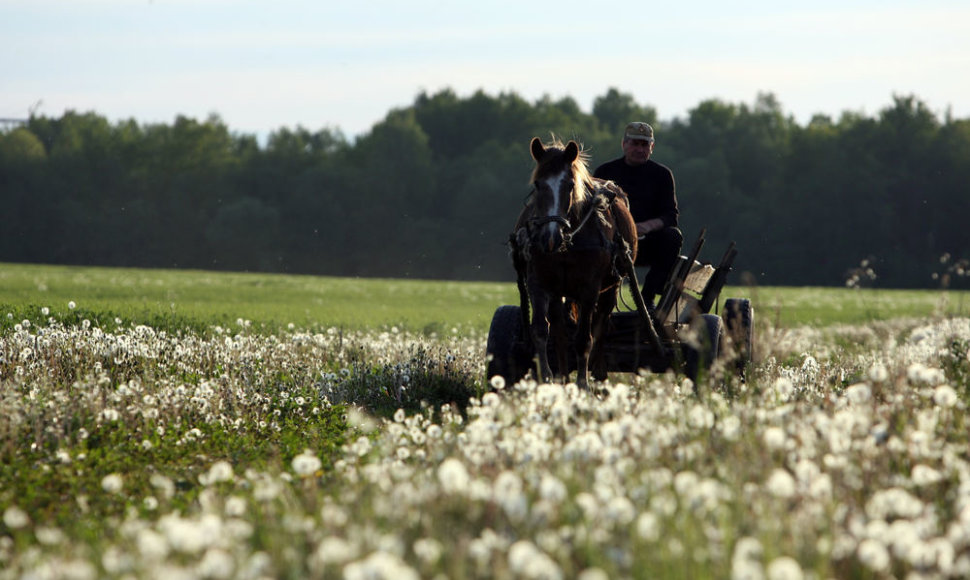“We want to get an accurate image of the desertion of Lithuania,” says Dr. Vidmantas Daugirdas of the Social Research Centre's Institute of Sociology and spreads out a map, the result of his research. Less than half of Lithuania's territory is coloured white – these are areas where population density is not yet a cause for alarm.
More districts are painted grey and some stand out in deep black shades. In these districts, the human population is an endangered species.
It was Ričardas Baubinas, former director of the Institute of Geography, and Dr. Daugirdas who came up with the idea, ten years ago, to see population densities across Lithuania. Dr. Daugirdas stuck to the plan and continued research mostly out of personal curiosity. This year, he invited his colleagues to join him in a project “Lithuania's Underpopulated Territories and Their Inhabitants,” funded by the Lithuanian Science Council.
How to define an underpopulated territory? Before, one of the criteria in applying for EU support was low population density. An agreed limit was 10 residents per square kilometre.
Dr. Daugirdas, doubting whether the figure was adequate for Lithuania, settled on 12.5 people per square kilometre. Six years ago, there were 71 elderships (the smallest administrative unit in Lithuania), out of 546, with population density below the limit. Now there are around 150.
Researchers decided on three approaches to investigate these territories: to interview their community leaders, the so-called elders; a hundred GDP-producing farmers, and ordinary residents. Over three weeks of July this year, the researchers interviewed 600 randomly-selected people in 45 elderships.
Life in Lithuania is not bad
Daugirdas says the picture that he and his colleagues came up with is rather equivocal. They were prepared to hear complaints and laments. “But most of the people were disposed positively – about 90 percent of people whom we asked “Do you like living in your area?” replied either “I like it” or “I like it a lot.”
“People were commending their environment – clean, beautiful, quiet, much forestry, lakes – many were old acquaintances with their neighbours. They would often say that their life hadn't changed. A third think life will improve, another third that it will get worse, the rest don't expect any change, but that is also a positive answer. It means that life in Lithuania isn't bad.”
The merry Viešvilians
According to Dr. Daugirdas, a lot depends on who the elder is. If he or she moans all the time, so is the community unhappy with everything. And if the elder is energetic, life seems much brighter. A case in point is the first eldership that he surveyed – Viešvilė (district of Tauragė) where he himself spent some time living.
“We were hit by positivity. My colleagues and I discussed why it was so. I've known the elder for a long time, he has great authority in the community, he is a rational, active, but not hotheaded person. Community life is well-organized, they hold Viešvilė Days, other festivals, exhibitions of painting and knitting. Life is boiling there,” Daugirdas seems surprised.
One good-humoured Viešvilian bought lottery tickets for himself and two researchers who interviewed him. He was the lucky one, so he treated his guests with sweets.
Community wind power plant
“It might be subjective, but my view is that Lithuania is changing for the better. Country houses are well kept, lawns are mown, flowers bloom. It wasn't so fifteen years ago,” Dr. Daugirdas notes. “People now have time, will, and money to clean up their environment. One colleague told me: 'Where have you seen a villager scything grass outside his house? Everyone is driving a mower.' Wherever there are more farmers, every other farm owns a tractor or harvester worth half a million if not more. Is that bad life? But if you ask someone, he'll tell you he lives bad.”
Active citizens upkeep their own yards but can also implement rather ambitious communal projects. For example, the community of Smalininkai built a wind power plant. They also applied for EU support to mend roads, schools, other communal structures.
According to Dr. Daugirdas, there are still plenty of neglected buildings, but they are different. They are shabby not because of negligence, shortage of money or time, but because there's no one living inside.
Shortage of land
Interviews with elders, farmers, and other people suggested to researchers that the biggest problem plaguing Lithuania's provinces was unemployment. It is difficult to start up a business or farming – there is a great shortage of labour and land.
Several-hectare farm is barely sufficient to support one family. Those who seriously want to make a living on farming have to expand. However, land they could buy or rent is already divided up. That is especially true of the northern regions where farming is profitable. Particularly with EU support, which big farmers don't even need that much, but smaller ones couldn't do without.
And yet, there is much land lying waste in Lithuania, particularly in arid and hilly north-eastern provinces. Farmers interviewed by Dr. Daugirdas claimed they did not own such land. Unused plots usually belong to city dwellers who are unwilling to give their property for farming, sell, or work it themselves – they are only waiting for the opportunity to sell it to foreigners, farmers claim.
Welfare seekers
Dr. Daugirdas was somewhat surprised to find out what the second major problem was. “I had no idea there was so much resentment. Whenever you ask an elder about people receiving benefits, he explodes. Ordinary residents, too, see them as a big problem, sometimes even more serious than unemployment. Elders complain: “If I give work to a receiver of benefits, I'll have to stand nearby, otherwise he might cut his legs off while drunk. The latter retorts: 'I won't be brooming your streets for several hundred litas, what will neighbours think of me?' They are not ashamed of doddering drunk, but work is a humiliation.”
Dr. Daugirdas tells about a moor in Gaurė (district of Tauragė) that caught the attention of German investors. Old employees stayed, but recruiting new ones is difficult, since no one wants to toil.
When asked how to save the Lithuanian province, most people suggested creating more jobs. “If that worked, there'd already be plenty of jobs. Now, if a businessman comes, sets up a factory, who is going to work there? That's why they don't come. Farmers keep complaining – 'I need to hire help but I can't find anyone.' They sometimes have to go to other districts to hire farmhands,” the researcher shares.
One employee at Videniškės (district of Molėtai) put it bluntly: Why create jobs if there is no one to take them. There are no employable people left, only pensioners and asocial types.
No babies
Indeed, some elderships are two-thirds pensioners. Several years ago, Daugirdas found only one eldership where not a single baby had been born over a year.
“It's hardly conceivable – there were several thousand people living there,” the researcher was surprised at the old statistics. The updated figures, however, are even more disturbing – the researchers found at least 5 to 7 areas without newborns. Death and emigration rates, meanwhile, did not go down.
In the end, it is a vicious circle. Villages still have shops, drugstores, schools, other public service institutions. But they keep closing down one after another as population dwindles. The same is true of medical stations.
The population in Eičiai (previously Laukėsa, Gaurė eldership) is almost 500 and it is located on a good road connecting Tauragė and Jurbarkas. However, a bus to Gaurė goes only once a day, 7:30 in the morning. It doesn't come back.
“I asked people – how are things with transportation? They said, OK, because they owned cars. It is only tricky for those who do not own one. On the other hand, you could have ten buses stopping regularly, but who is going to ride them?” Daugirdas asks.
He says that the picture he got from his research can help predict the future for Lithuania: “I'm not saying things won't change or it will end in a disaster. The situation will adjust in the long run, but it's hard to say when. One day it will pay off living in the country. Lithuanians are, after all, hard-working people, they lean towards earth, they will work neglected land, populate and renew some of the abandoned farmhouses.”
Population density like in the mountains
According to Statistics Lithuania, Kaunas, Lithuania's second-biggest city, now has only 330 thousand people left. Over the last twenty years, the population of Panevėžys shrunk from 126 thousand to 107 thousand people. Klaipėda used to have 207 thousand residents and now only 170 thousand.
Dr. Daugirdas' map paints the entire north-east Lithuania – region known for its lakes and forests – in grey, but these have never been densely-populated areas.
Almost the entire district of Rietavas is approaching underpopulation, also Akmenė, some elderships in forested Jurbarkas and Tauragė districts. The situation is much better west of the river Nemunas, but these territories are not as forested and have more fertile soil. A black spot marks a sad record near the Belorussian border – Marcinkonys is the least populated eldership in the country, with barely 1.8 people per square kilometre.
“Almost like the Sahara desert,” Daugirdas compares. Kazitiškis (district of Ignalina), Labanoras, Sariai (district of Švenčionys), and Kapčiamiestis (district of Lazdijai) have population densities of under 5 people per square kilometre.
Even though Lithuania is in one of the best-suited areas for living – in terms of climate, water supply, likelihood of natural disasters – its overall population density is under 50 people per square kilometre. The figure is very low and is more likely in mountainous, forested areas less suitable for living. In neighbouring Poland, the population density is twice higher.
Back to the countryside
Not all people move from villages to cities. Increasingly many newcomers settle in the countryside too. Some of them are former emigrants who have saved up enough money to buy a farm and build a new house. Some newcomers move to live a greener live, while others are retired people who cannot afford to live in a city, but sell their flats and have enough money for an entire country house.
One interviewed artist said she was happy to exchange her busy life in Vilnius for a much calmer routine in the country. There are more people like her who are usually well educated and self-employed or able to work from any place with an internet connection.
Villages that are close to bigger urban areas often turn into seasonal settlements – city people often buy properties there and come for the summer. The elder of Salakas (district of Zarasai) jokes that he will soon have to board up all windows for the winter and open them up again when summer comes. Tauragnai in Utena district already resembles a residential quarter of Utena – it is comfortable to live in, compact, roads are good, there are lakes nearby. Yet children, instead of going to local schools, attend schools in Utena.













